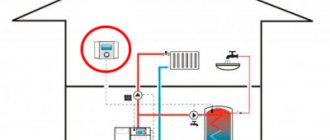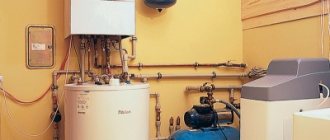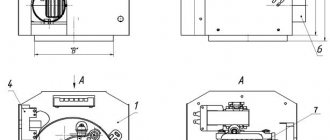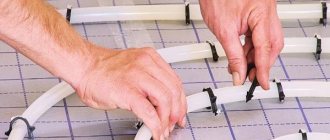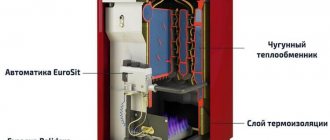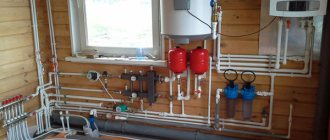Basic criteria for choosing a thermostat
In total, there are several types of equipment based on the principle of their design. Mechanical and electronic, which are connected via cable, so installation is best done during repair work. Wireless electronic models are much more expensive, but justify their price with functionality and ease of use.
Thermostats for gas boilers
When choosing a thermostat, it is important to consider not only the type of connection, but also the necessary functionality of the device:
- maintaining a fixed temperature in heated rooms;
- adjustment accuracy;
- price;
- ease of operation and installation;
- compatibility with existing gas boiler.
When choosing an electronic model, it is better to stick to the devices recommended by the boiler manufacturer itself. They will be indicated in the compatibility data sheet.
The premium segment includes models with a Wi-FI module and voice control function. Such devices are used in smart home systems and allow you to control all settings remotely from a smartphone.
Types of thermostats for gas boilers
Thermostats can be divided into three main types: mechanical, electronic and electronic wireless.
Wired models cost less, but require cable laying - it is better to install a thermostat on a gas boiler before or during renovation work in the house. Wireless models are more expensive, more functional, and more convenient.
The selection of a thermostat for connection to a gas heating system is carried out taking into account the following basic criteria:
According to functionality they are distinguished:
Separately, it is necessary to say about programmers - thermostats that are more complex in terms of functionality, which are installed, among other things, to control climate systems in so-called smart homes.
READ Bluetooth speaker jbl clip 2 how to connect to a laptop
Programmers control the operation of not only heating and water heating equipment, but also air conditioners, pumps, and other devices. Some of them help to program individual temperature conditions for each day of the week with the ability to set from 1 to 6 fixed operating points.
General connection principles
The diagram for connecting the thermostat directly to the heating equipment is always indicated in the technical documentation attached to the gas boiler. Modern equipment from any manufacturer is equipped with connection points for a temperature control device.
When using a wireless thermostat, the measuring unit is placed in the living room. It is recommended to install it in the coldest room or where people are most often present.
You should not install a thermostat unit in a kitchen or boiler room where the temperature regime is unstable.
Basic installation rules include:
- the height of the location should not exceed 1.5 meters from the floor level;
- do not attach to a cold or external wall of the room;
- prevent exposure to direct sunlight;
- exclude installation in close proximity to gas stoves, air conditioners and frequently opened windows.
Installing the Thermostat
The thermostat should be located in an easily accessible place for the most convenient operation and subsequent maintenance.
Types of thermostats
Thermostats fall into two main categories: mechanical, which are simpler in design and cheaper, and electronic, which are more intuitive and functional.
Mechanical thermostats are adjusted using a rotary temperature control wheel and an on/off button. The error of such a thermostat is usually 1-1.5 degrees. The thermostat operates using a special gas, the volume of which changes when the room temperature deviates from the set norm. When the temperature increases or decreases, the mechanical thermostat opens or closes the contacts, thereby turning on or off the burner in the boiler.
Electric thermostats are a little more complicated, but easy to use. Usually they have a display and several function buttons, with the help of which the temperature is regulated. At the same time, on many models you can also set different temperature conditions for day and night, thereby creating a comfortable temperature for sleep. This feature is also useful for work areas after work hours. This allows you to reduce gas costs.
The choice of one of the options depends entirely on your needs and boiler model. Some manufacturers of gas equipment recommend using mechanical thermostats for their equipment, since they do not support high-tech electronic ones. Therefore, before purchasing a thermostat and connecting it to the boiler, it is imperative that you familiarize yourself with the technical characteristics of your boiler and its compatibility with various devices.
Mechanical thermostat installation diagram
Mechanical equipment is distinguished by its simplicity of design, low price, reliability and long service life, subject to compliance with operating rules. The device supports one temperature mode, regulated by fixing the position of the handle at the corresponding mark on the degree scale.
To connect to a gas boiler, connect the ends of the wire to the NO terminal, then mount the control unit on the wall in the living room, in accordance with all rules and regulations. The mechanical device has the simplest principle of operation, during which the circuit opens and closes via a bimetallic plate.
General diagram of the thermostat operation
When installing, you must pay attention to the markings that are found on all modern models of temperature control equipment. Thus, having the diagram in front of your eyes, the risk of incorrect connection will be eliminated.
Connecting a room thermostat to a gas boiler: thermostat installation guide
Saving electricity and gas, a stable comfortable temperature, a minimum of time spent on adjusting heating equipment - all these are not whims, but well-founded requirements for a properly organized heating process.
Therefore, connecting a room thermostat to a gas boiler, to ensure all of the above conditions, becomes an obvious necessity. We will talk about the principle of operation of the thermostat and the types of the device. Let's look at the differences in functionality of different models.
The article describes in detail the principles of connecting a temperature controller. Rules for installing different versions of the device are given. By following our recommendations, you can complete the installation yourself, without the help of heating engineers.
Electronic thermostat installation diagram
This category of devices is distinguished by the presence of an electronic board, which will be responsible for controlling and adjusting all input parameters on the gas boiler. This type of thermostat will require a power supply.
Before starting installation, all equipment should be completely disconnected from the electrical network.
Installation of an electronic thermostat
Electronic thermostats allow for more detailed adjustment of the operation of the entire heating system. When installing the device, a power cable and neutral are supplied to it. The device supplies voltage to the input of the gas boiler in order to start all the equipment.
Connection diagram
Almost all thermostats existing on the modern market are relay. This means that they operate via a relay that opens and closes contacts based on a temperature preset by the user. As a theoretically connected thermostat, we will use an electric relay-type thermostat with dry contacts. Dry contacts are a term that means that in any state, closed or open, there is no voltage across the contacts.
To connect to the boiler, there are terminals on the thermostat; you need to connect the open and common ports. If they are not indicated in the manual for your specific model, you just need to ring the contacts with a tester. Next, we need to make sure that the thermostat can be connected to the boiler. Usually this is indicated directly in the technical documentation; if there is none, then the information can be easily found in any of the search engines.
The found electronic circuit diagram of the board indicates the location of the very jumper into which the thermostat will be connected to the boiler. Depending on the boiler model, you will have to unscrew several bolts to get to the required part. The block can be installed either on the control board or taken out separately. Connecting the thermostat for any of these options will be no different.
Next, you need to pull out the jumper, and in its place put the cable supplied with the thermostat (or purchased separately). This is a two-core wire with a cross-section of at least 0.75 square millimeters. The polarity when connecting does not matter. The cable is connected to the thermostat control unit into the normal open and common ports, as described above. The ports are located on one side of the control unit, and on the other there are ports for connecting the power supply cable. You can either purchase a new cable of the desired cross-section or use the complete one.
This completes the connection of the thermostat to the gas boiler. All that remains is to check the functionality of the system. On the thermostat we set the required air temperature in the room, the signal is transmitted to the control unit and, depending on the set temperature, the relay contacts close or open. When setting a temperature that is lower than the current one, the burner starts heating the water in the system; when setting a temperature higher, the burner, on the contrary, starts working.
Wireless thermostat installation diagram
Unlike other types, a wireless thermostat consists of two blocks:
- It is installed in the room and plays the role of a transmitter.
- It is mounted in close proximity to the gas boiler and connected to it via a valve or a special controller.
Data is transferred between blocks via a radio signal. Control is realized using a keyboard located on the control unit. All mode changes are displayed on the built-in display.
The main disadvantage of the category of wireless thermostats is power, which is provided through separate batteries that have a limited resource and require regular replacement. If it is necessary to update the batteries, a special signal is transmitted, notifying that the batteries are about to fail.
Related video: Wi-Fi thermostat for a gas boiler or boiler
Advantages of using a thermostat in heating
Gas heating is a benefit in itself and significantly increases the quality of life. But simplifying the management of gas heating equipment is an equally pressing issue.
Setting up and controlling the operation of a gas boiler can be done in two ways - manually or using a thermostat, which will automatically ensure a stable temperature regime.
Manual adjustment helps set a certain temperature of the coolant in the system - when the temperature rises to the set values, the boiler turns off, when it decreases, it turns on. As a result, the temperature in the house is maintained at a certain level.
But as the temperature outside changes, the set mode turns out to be incorrect and you have to manually reprogram the heating device. Such manipulations are carried out throughout the heating season, and this is inconvenient.
In addition, manual adjustment means the gas boiler operates in a constant on-off mode, with a working cycle period of about 10 minutes. This does not have the best effect on the operating time of the boiler.
Even in a system with manual adjustment, regardless of the operation of the heating function, constant circulation of the coolant is ensured using pumping equipment, which means that excess electricity is consumed.
Automatic control, unlike manual control, turns off the circulation pump. By reacting to the temperature of the air in the room, and not the coolant in the heating circuit, the thermostat for the heating boiler maintains a stable temperature in the room.
As a result, the microclimate in the house is significantly improved, the frequency of boiler switching on is reduced, which means its service life increases.
Using a thermostat provides other benefits:
These are just some of the obvious advantages common to all types of thermostats. The advantages of individual models can be studied in more detail immediately before purchase.
Thermostat benefits
As a result of installing thermostatic equipment in the gas heating system, the microclimate in all rooms is significantly improved. The boiler itself operates stably, reducing the frequency of switching on, which has a positive effect on its service life. Other benefits include:
- the temperature regime is recorded, depending on the needs and time of day;
- problems with excessive switching on and off of the heating boiler are solved;
- it becomes possible to fine-tune;
- ease of use is improved.
Related video: How to connect a thermostat to a gas boiler - detailed instructions
There is nothing complicated about connecting a thermostat to a gas boiler yourself. The main thing is to follow all available instructions and carefully study the diagrams available in the technical documentation of the equipment. Thus, it will be possible to increase the efficiency of the entire heating system.
Infrared heaters with a thermostat for a summer residence, you can read about this at the link.
How to connect a room thermostat
The thermostat is installed in strict accordance with the operating instructions supplied by the manufacturer. Violation of installation rules can lead to thermostat failure. Depending on the design, the installation method of the product differs.
Connection diagram
Depending on the technical characteristics, a 220-volt household network or a DC power source can be used as a battery.
Schematic connection of the regulator to a boiler with a boiler
To connect to the electrical circuit, you must follow the operating instructions. To properly connect an electrical appliance to the network, it is better to contact specialists.
Selection of installation location
It is recommended to install the device in places with average room temperature. Installing the product near window or door openings, ventilation shafts and air conditioners may negatively affect the correct determination of the temperature indicator. The installation height on vertical surfaces plays an important role when choosing a mounting location. Cold air sinks down, the upper layers have a higher temperature. The product should be mounted at a height of 1.5 to 2 m. When choosing an installation location, it is necessary to take into account that for normal operation there must be unobstructed access to the device.
Installation and connection
Before connecting the room thermostat to the gas boiler, you must carefully study the operating instructions. Wireless models are easy to install. It is necessary to connect the receiver to the boiler automation, and install the transmitter on a vertical surface of the room.
Installation of wire structures is carried out in several stages:
- Open the gas boiler panel, which blocks access to the automation.
- In accordance with the operating instructions, connect the wire to the boiler control board.
- Install wiring in an open or closed way to the installation location of the room thermostat.
- Attach the regulator to the wall.
- Connect the wires coming from the gas boiler to the device.
- Connect the thermostat to a household power supply.
After startup, you need to check the functionality of the product and set the required operating mode. The setting of the room regulator differs depending on the design of the device. Connecting a room thermostat to a gas boiler reduces the degree of human participation in the operation of the heating system. The ability to adjust allows you to maintain a comfortable room temperature and save fuel.
